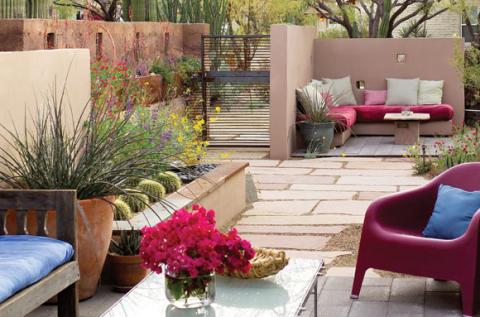Eco-friendly gardening is all about working with nature, not against it. The design can take on many looks depending on the site you have in mind. A wetland area will look different, for instance, than a miniature grassland prairie. The ideal eco-garden is made up of native species, and often becomes habitat for birds and butterflies.
Guiding Principles of an Eco-Garden
Being green is really about not being wasteful. In the garden, that means not wasting water recycling yard trimmings and kitchen plant-based scraps into compost, and wisely disposing of plastic pots, soil bags, etc. The next important rule is to do no harm. Like avoiding chemical fertilizers that run into rivers, oceans and wetlands and not planting invasive species that could wipe out some native varieties. Pesticides and herbicides tend to kill many more creatures than the one or two bugs you’re trying to be rid of. Lastly, the eco-garden gives back. By creating a friendly wildlife habitat and you’ll provide food and shelter for birds, butterflies, lizards, ladybugs and other good critters. By including edibles in your garden, you can give delicious fruits and herbs to your family and friends. You don’t have to choose between an edible and an ornamental garden. Most fruit trees and shrubs, and aromatic herbs are quite beautiful. We call this blending of styles Farmer Chic.
Designing to be water-wise
Using water judiciously does not mean having less greenery, it just means putting more thought into plant selection and garden design. The desire to reduce water usage can inspire fabulous plant combinations, year-round interest and gardens that people want to live in. A good place to start is to evaluate your lawn. Pets and kids need their turf grass, but can you reduce the size of the lawn. Check to see if the newer low-water use grasses will flourish in your climate.
Choose the right plants
Plant choice is an essential component of the water-wise garden. Opt for plants that are native to your region, or native to a place with similar climate conditions, so they’ll be more likely to thrive with minimal irrigation. Check out newer varieties. Monrovia is constantly searching for new plant varieties that have improved characteristics like drought tolerance, pest and disease resistance, more abundant and better tasting fruit, more abundant flowering, and low maintenance. Search our plant catalog for the varieties that don’t need much water once they’re established. Now, if you have some favorite thirsty plants you simply can’t live without, it’s OK — just group them together so you’re only watering heavily in one area. Be sure to add a thick layer of mulch to reduce evaporation.Grouping plants the right wayA key water-conserving strategy is to group plants with similar water and sun needs. A Lavender, Lavandula, in a full-sun, sandy-soil spot is a great idea; but planting a water-thirsty perennial next to it defeats the purpose as one or both plants will suffer. Think of your garden in zones and arrange the plants according to various conditions. Attending to the light needs of plants can help you save water, because a shade-lover that is planted in the sun has higher water needs than if it is sited appropriately. Full sun can be too harsh for woodland plants, and even half-day sun, if it is in the hot afternoon, may be too much. But those same woodland plants in half-day morning sun may have it just right.Using compostNext, help retain soil moisture with an application of organic mulch, such as high-quality compost. The benefits from this are many: its loose material of varying sizes slows water down, so that more moisture goes into the soil instead of running off. Water does not evaporate from the soil surface as quickly. Mulch provides nutrients to the soil and helps suppress weeds. Mulch can be applied three inches thick in existing ornamental beds, with just a few precautions. Do not pile it up against the trunks or stems of shrubs, and use only a thin layer around Rhododendrons and other shallow-rooted shrubs. Go easy with the compost around the few perennials, such as Astilbe, Astilbe, Lenton Rose, Helleborus, and Peonies, Paeonia, that prefer a more alkaline environment because compost can be slightly acidic.




